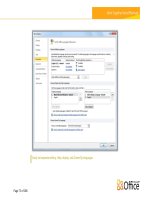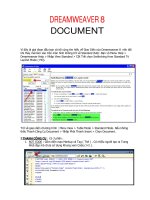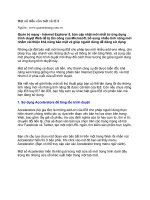Instructor Inputs - Session 8 doc
Bạn đang xem bản rút gọn của tài liệu. Xem và tải ngay bản đầy đủ của tài liệu tại đây (1.01 MB, 14 trang )
Instructor Inputs
Session 8
¤NIIT Instructor Inputs 8.3
This session includes section one of Chapter 6 of the Student Guide.
Slide 1
Slide 1 of 17Session 8
Ver. 1.0
Querying and Managing Data using SQL Server 2005
In this session, you will learn to:
Create and manage indexes
Objectives
Begin the session by sharing the objectives with the students. In this session, the students
will understand the requirements of indexes. Next, they will learn how to create and
manage indexes.
Session Overview
8.4 Instructor Inputs ¤NIIT
Slide 2
Slide 2 of 17Session 8
Ver. 1.0
Querying and Managing Data using SQL Server 2005
Flash presentation: Implementing Indexes
Index:
Is a data structure associated with a table
Enables quick access to data
Accelerates queries that join tables, and perform sorting and
grouping
Can be used to enforce uniqueness of rows
Contains a collection of keys and pointers stored in B-Tree in
the memory
Identifying Type of Indexes
In this topic, you need to explain the concept of indexes to the students.
Begin with showing the flash presentation. The presentation explains the usage of
indexes.
Inputs for Flash Presentation
You can use the following points to explain:
Screen 1
Explain that data for every table is stored in data pages.
Screen 2
A table is internally represented as a collection of data pages. With increase in the volume
of data the number of data pages increases.
Screen 3
When a user searches for data, the database engine searches through all the data pages.
This takes time to retrieve the required data. Highlight the time taken by the query to
execute.
¤NIIT Instructor Inputs 8.5
Screen 4
SQL Server allows implementing indexes. An index is a structure that stores the key
values and pointers to those values. After an index is implemented, if a user queries for
data, the index is searched for the required value and the record is picked from the data
page whose pointer is stored in the index. This increases the speed of the data search.
Bring the attention of the students to the reduced time spent to process the user query.
While teaching the topic, mention the advantages of using indexes. Mention that indexes
are used to speed up queries and are created on columns that are used in joins, the
WHERE clause, the ORDER BY clause, or the GROUP BY clause.
You can mention the following for indexes:
Creating multiple indexes on a column is not a good practice. Therefore, before
applying an index, it is necessary to check the requirement of an index. Indexes are
always created on columns that are queried most.
When constraints like the primary key constraint are applied on a table, indexes are
created in the database engine.
A unique index enforces uniqueness on the column for which it is mentioned. If nulls
are allowed, it will allow only one NULL. A second null value will become a
duplicate. A unique index can be clustered or non-clustered, the default is clustered.
If a primary key constraint is not created, then a unique clustered index can be used
to implement the primary key and entity integrity. However, a foreign key constraint
cannot reference such a column since a primary key constraint is not defined.
However, in such cases, referential integrity can be implemented from the child table
by using a trigger.
8.6 Instructor Inputs ¤NIIT
Slide 3
Slide 3 of 17Session 8
Ver. 1.0
Querying and Managing Data using SQL Server 2005
Indexes are of two types:
Clustered index
: Sorts and stores the data rows in the table
based on their key values.
Nonclustered index
: Contains the index key values and row
locators that point to the storage location of the data but the
physical order of rows is different.
Identifying Type of Indexes (Contd.)
In this topic, you need to explain the concepts of clustered index and nonclustered
indexes. You need to only explain the definitions of these concepts.
Slide 4
Slide 4 of 17Session 8
Ver. 1.0
Querying and Managing Data using SQL Server 2005
Working of a Clustered Index:
Identifying Type of Indexes (Contd.)
In this topic, you need to explain how a clustered index searches for a particular string.
You can refer to the Student Guide to explain the steps.
¤NIIT Instructor Inputs 8.7
Slide 5
Slide 5 of 17Session 8
Ver. 1.0
Querying and Managing Data using SQL Server 2005
Working of a NonClustered Index:
Identifying Type of Indexes (Contd.)
In this topic, you need to explain how a nonclustered index searches for a particular
string. You can refer to the Student Guide to explain the steps.
Slide 6
Slide 6 of 17Session 8
Ver. 1.0
Querying and Managing Data using SQL Server 2005
Index:
Is created on the most frequently queried column in tables or
views
Based on two or more columns is called a composite index
Can be created by using the CREATE INDEX statement
Creating Indexes
In this topic, you need to explain the guidelines to be followed while creating an index.
The guidelines are given in the Student Guide.
8.8 Instructor Inputs ¤NIIT
Slide 7
Slide 7 of 17Session 8
Ver. 1.0
Querying and Managing Data using SQL Server 2005
Syntax:
CREATE [UNIQUE][CLUSTERED | NONCLUSTERED]
INDEX
index_name
ON [{database_name.[schema_name]. |
schema_name.}]
{table_or_view_name}(column [ASC |
DESC][, n])
[INCLUDE (column_name [, n])]
[WITH(<relational_index_option>[, n])]
[ON
{partition_scheme_name(column_name[, n])
| filegroup_name | DEFAULT}]
Creating Indexes (Contd.)
In this topic, you need to explain the syntax of the CREATE INDEX statement. In
addition, you need to describe the various parameters of the CREATE INDEX statement.
While creating an index, the FILLFACTOR can be mentioned. The FILLFACTOR is a
percentage to which the leaf level pages of the index are filled up. Similarly, PAD INDEX
can be used to mention the number of non-leaf level pages that are filled. PAD INDEX
cannot be used without fillfactor. A separate percentage value cannot be mentioned for
PAD INDEX as it takes the fillfactor value only.
¤NIIT Instructor Inputs 8.9
N
ote
Slide 8
Slide 8 of 17Session 8
Ver. 1.0
Querying and Managing Data using SQL Server 2005
<relation_index_option>::= {PAD_INDEX = {ON
| OFF}
| FILLFACTOR = fillfactor | SORT_IN_TEMPDB
= {ON | OFF}
| IGNORE_DUP_KEY = {ON | OFF}
|STATISTICS_NO_RECOMPUTE = {ON | OFF}
| DROP_EXISTING = {ON | OFF} | ONLINE = {ON
| OFF}
Let’s see how…
Creating Indexes (Contd.)
Demonstrate how to create an index by executing the example given in the Student Guide.
Before creating the index, log on by using sa and execute the CreateTable.sql data file
present in the Chapter 6\Instep Demo folder. This file will drop the Employee table
created when teaching chapter 3. It will further create a copy of the Employee table of the
HumanResources schema and name it as Employee. It will further copy the data from the
HumanResources.Employee table to the Employee table.
Before running this inline demo, you need to create an Employee table by executing the
CreateTable.sql script file present in the Datafiles_for_faculty\QMDS2005\Chapter 06
folder of the TIRM CD.
During the demo you will apply an index on the Employee table created by the sql script.
This is because the HumanResources.Employee table already has few indexes applied on
it.
8.10 Instructor Inputs ¤NIIT
Slide 9
Slide 9 of 17Session 8
Ver. 1.0
Querying and Managing Data using SQL Server 2005
XML Index:
Can be created on columns storing XML data values
Supports indexing only on a single XML column
Is of two types:
Primary XML index
Secondary XML index
Creating XML Indexes
In this topic, you need to explain the concept the XML Indexes to the students. Explain
that you can create XML indexes on the columns that store the XML data. The XML
indexes are categorized as primary and secondary XML indexes. Demonstrate these
concepts using the example given in the Student Guide.
You can read more about these topics on the msdn.
Slide 10
Slide 10 of 17Session 8
Ver. 1.0
Querying and Managing Data using SQL Server 2005
Just a minute
Which type of index implements physical sorting of data?
Answer:
Clustered index
¤NIIT Instructor Inputs 8.11
Reiterate the concepts taught earlier by asking the given question.
Slide 11
Slide 11 of 17Session 8
Ver. 1.0
Querying and Managing Data using SQL Server 2005
Just a minute
Which type of an XML index is created first on the table?
Answer:
Primary XML index
Reiterate the concepts taught earlier by asking the given question.
Slide 12
Slide 12 of 17Session 8
Ver. 1.0
Querying and Managing Data using SQL Server 2005
Just a minute
Which of the following is used to specify the percentage of
space to be used for each index page?
1. Fill Factor
2. Pad Index
3. Path Index
4. Value Index
Answer:
1. Fill Factor
Reiterate the concepts taught earlier by asking the given question.
8.12 Instructor Inputs ¤NIIT
Slide 13
Slide 13 of 17Session 8
Ver. 1.0
Querying and Managing Data using SQL Server 2005
Involves:
Disabling indexes
Enabling indexes
Renaming indexes
Dropping indexes
Optimizing indexes
Let’s see how…
Managing Indexes
In this topic, you will explain how to disable, enable, rename, delete, and optimize
indexes. You can use the examples given in the Student Guide for demonstration.
Tell the students that the indexes created by creation of constraints like the primary key or
unique constraints cannot be dropped by using the DROP INDEX statement. To drop
these indexes, you need to drop the constraint.
Slide 14
Slide 14 of 17Session 8
Ver. 1.0
Querying and Managing Data using SQL Server 2005
Demo: Creating Indexes
Problem Statement:
The production manager of the AdventureWorks, Inc. needs to
frequently view data from the Product table in the Production
schema. He needs to frequently search for data based on the
product number.
The Product table contains a large volume of data, and
therefore the query takes time to execute. To reduce the time
taken in the execution of the query, you need to suggest a
solution to improve performance. For this, you need to check
the performance of the query before and after applying the
suggested solution.
¤NIIT Instructor Inputs 8.13
At the end of this demo, the students will be able to create indexes.
Demo Handling Tips
To perform this demo, you need to provide the SHOWPLAN permissions to the user
account that you are using to perform the demo.
During the demo you need to create an index on the ProductNumber column of the
Product table in the AdventureWorks database. The table already contains an index on the
ProductNumber column. The name of the index is AK_Product_ProductNumber.
Therefore, before performing this demo, you need to drop the existing index by executing
the following statement:
DROP INDEX [AK_Product_ProductNumber] ON [Production].Product] WITH (
ONLINE = OFF )
Slide 15
Slide 15 of 17Session 8
Ver. 1.0
Querying and Managing Data using SQL Server 2005
Solution:
To solve the preceding problem, you can apply an index on the
column on which data is frequently searched. To apply an
index, you need to perform the following tasks:
1. Identify the column to be indexed.
2. Enable the display of query execution plan.
3. Check the I/O cost of the query.
4. Create an index to improve performance.
5. Verify the improvement in query execution.
Demo: Creating Indexes (Contd.)
In task 3 of the solution, the execution plan will display an icon of a clustered index scan.
Tell the students that this index is applied on the ProductID column. However, in the
demo, an index is to be applied on the ProductNumber column.
8.14 Instructor Inputs ¤NIIT
Slide 16
Slide 16 of 17Session 8
Ver. 1.0
Querying and Managing Data using SQL Server 2005
In this session, you learned that:
Indexes are created to enhance the performance of queries.
There are two types of indexes, clustered and nonclustered.
Indexes are created by using the CREATE INDEX statement
Clustered indexes should be built on an attribute whose values
are unique and do not change often. Data is physically sorted
in a clustered index.
In a nonclustered index, the physical order of rows is not the
same as that of the index order.
A nonclustered index is the default index that is created with
the CREATE INDEX command.
Summary
Summarize the session.
Slide 17
Slide 17 of 17Session 8
Ver. 1.0
Querying and Managing Data using SQL Server 2005
An XML index is built on columns with the XML data type.
The common index maintenance tasks include disabling,
enabling, renaming, and dropping an index.
Summary (Contd.)









